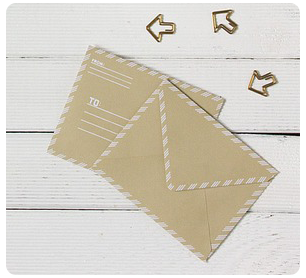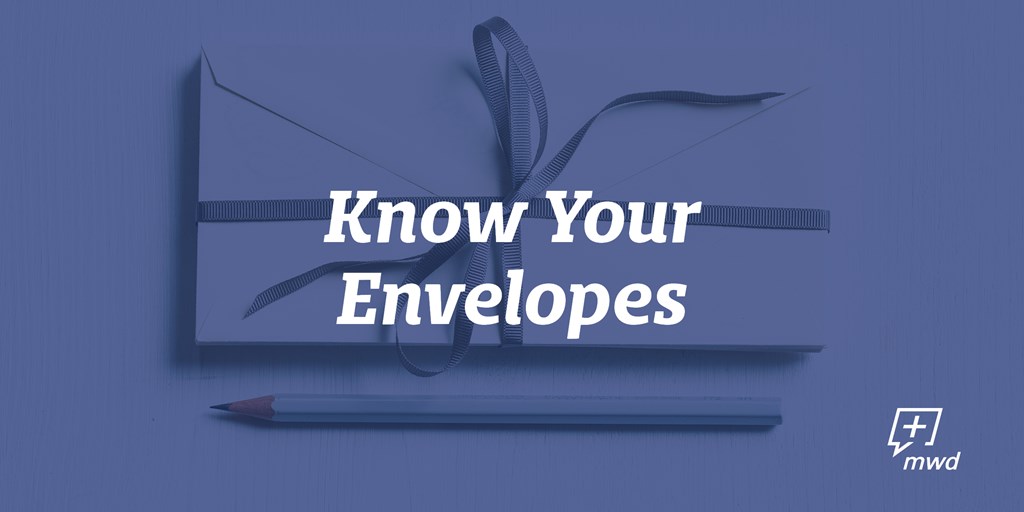Although you get them in the mail every day and you’ve probably sealed a fair share of them yourself, chances are you haven’t given much thought to envelopes. A good envelope, however, can make or break a message – they can bring about feelings of fear (hello, credit card bills!) or feelings of excitement. As a marketer aimed to stand out above the rest, it’s important to not only be prepared for what goes into the direct mail portions of your campaign but also know what the best options are for how those messages arrive.
Window Types
In the past, window envelopes were mostly used for bills. Lately, they have been used in creative ways for marketing purposes as well. If you are choosing to go with an envelope for your direct mail campaign, the first decision you’ll need to make is whether you want to have one window or two. Using a window envelope is an easy way to let your recipient get an idea of what your message contains while also dispelling fears of bills or urgent business messages.
The most common single window envelope size is 1 ⅛ x 4 ½. The position from the bottom-left may vary, but usually, it is around ⅞ from the left and ⅝ in from the bottom. A single window can display the recipient’s address as well as some teaser copy – be sure to use that space wisely!
Double windows, on the other hand, allow for more room for creativity: use the first window to display the address, and the second window for marketing content, further personalization or a call to action. Double windows vary in size and there aren’t any particular standards set in place, but the most common envelope sizes for double windows are check, #9, and #10 envelopes.
The material used for the window can be just as important. Here are some of the more common ones:
- Cellophane: Exceptional clarity, but very expensive.
- Colored film: Polystyrene film with color added to it. This type is great for creative direct mail purposes!
- Polyester film: Very durable and high-quality. Many laser printing applications use this type of film since it is resistant to high temperatures.
- Glassine: If you own an environmentally-conscious business, glassine is a great choice. It’s made of a vegetable-based material with no petroleum products. It’s a bit hazy, but this actually is a benefit when it comes to USPS optical readers where glare can sometimes be an issue. Glassine windows make the entire envelope recyclable.
- Polystyrene: This is the most popular type of window material, and for good reasons: it resists changes in humidity and is very flexible, so it’s often used in inserting equipment.
Envelope Seals
Choosing the proper adhesive for your envelope is important for many reasons, but at the end of the day it all boils down to the two C’s: confidentiality and confidence. Bill statements, reimbursements, and documents containing health information are typically pieces of mail that we wouldn’t want someone else to open – having a proper adhesive for these envelopes ensures confidentiality. On the other hand, sending promotional mail that isn’t sealed properly can lower our confidence in the security and effectiveness of that company. This is doubly true for businesses where both of these are combined – you wouldn’t want to receive a promotional letter from a local bank, for example, if the letter itself didn’t come across as secure.
When it comes to front seals, there are three main contenders to choose from:
- Remoistenable seals: These seals are typically made of a blend of dextrin (modified potato or corn starch) or synthetic resin emulsion and are the top choice for many due to working well with inserting machines.
- Latex seals: Latex seals, made of natural rubber latex, only adhere to themselves, allowing for a very strong and consistent envelope seal. These envelopes are great for confidential letters in which a strong seal is needed. Unlike remoistenable seals, however, latex seals have a shorter shelf life if exposed to heat, UV light, or dust.
- Pressure-sensitive seals: These types of envelopes are made with either a water-based or hot melt adhesive that allows the envelope to seal with only the application of pressure. The tacky adhesive is covered by release paper until adhesion is needed.

Some additional factors to keep in mind include
Humidity resistance: A good envelope seal will not be affected by changes in temperature and pressure during storage and transport.
Inserting performance: In order to have a mail campaign run smoothly and efficiently, front seals and inserting equipment need to get along! A good seal will lay flat and avoid excessive curling so that it may run through inserting, postage, and sealing machines properly.
Resistance to change during printing: Some printing processes use high temperatures that could cause envelopes with some adhesives to become too dry and not respond to the moisture needed for a proper seal. On the other hand, moisture can also be created during some processes, such as laser printing by hot fusing rollers. This moisture could cause some adhesives to start working earlier than needed. Be sure to do your research ahead of time and select an envelope with an adhesive that best fits the equipment and processes you will be using.
At Midwest Direct, our team can help you determine what type of envelope is best for your direct mail needs. Contact us today to get started!
